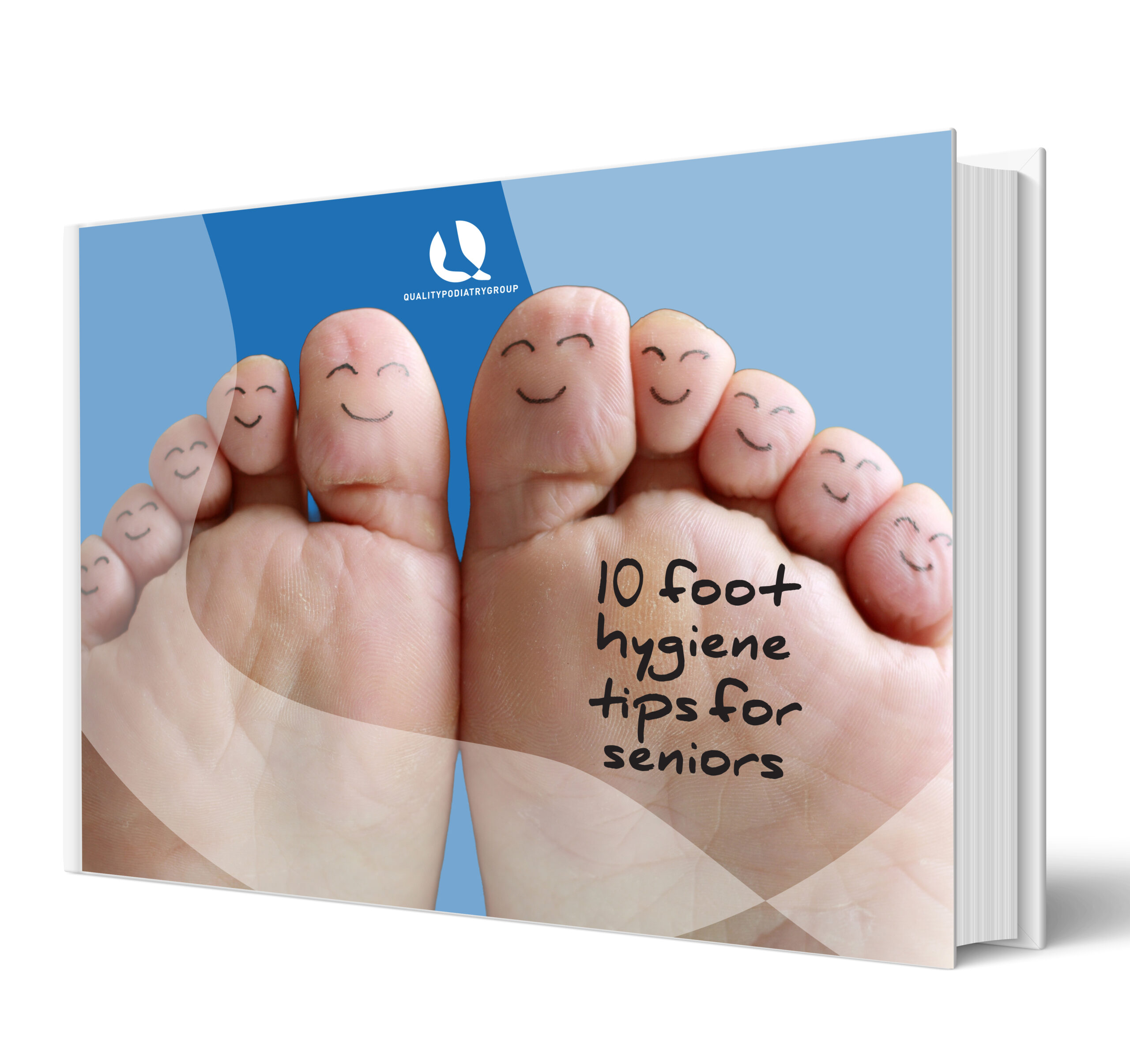When it comes to senior care, the focus is often on medication management, meals, and general health checks. But there’s one area that frequently gets overlooked: foot hygiene. Healthy feet are essential for mobility, comfort, and preventing infections—but many seniors simply can’t care for their feet on their own. That’s where staff play a crucial role.
As a practicing podiatrist for more than 30 years, I’ve seen how small, consistent steps in foot care can prevent big problems later. By following these practical tips, nursing home and assisted living staff can keep residents safer, healthier, and more comfortable—while also reducing preventable medical complications. Here is a complete guide for your staff that identifies the potential problems, outlines 10 implementable solution tips and explains why it is an essential step in ensuring all resident’s feet get the attention they deserve.

10 Foot Hygiene Tips for Seniors
Simple daily foot care helps seniors stay comfortable, mobile, and free from preventable infections.
1. Keep Feet Clean with Daily Washing
Problem: Many seniors struggle with reduced flexibility or mobility, making it difficult to wash their feet thoroughly. This can lead to the build-up of bacteria, fungus, and dead skin.
Tool/Tip: Use a mild, pH-balanced soap, warm water, and a soft washcloth or sponge to gently clean the feet every day. Staff should pay extra attention to the spaces between the toes where moisture tends to linger.
Why It Matters: Clean feet prevent fungal infections such as athlete’s foot, which can spread quickly in communal living environments. A daily foot wash also gives staff an opportunity to visually check for cuts, sores, or other changes that might need medical attention before they become serious.
2. Dry Feet Thoroughly, Especially Between the Toes
Problem: Moisture left between the toes is one of the leading causes of fungal infections. Seniors often skip this step or cannot reach their feet properly.
Tool/Tip: After washing, staff should use a soft towel or disposable paper towel to gently pat the feet dry.
Why It Matters: Trapped moisture creates the perfect breeding ground for fungus and bacteria. Thorough drying not only reduces infection risk but also prevents skin maceration, which can lead to painful cracks and secondary infections.
3. Moisturize, But Skip Between the Toes
Problem: Aging skin becomes thinner and drier, which can lead to painful cracks that make walking difficult and open the door to infection. However, applying lotion improperly—especially between the toes—can actually worsen fungal issues.
Tool/Tip: Use a non-greasy, fragrance-free moisturizer and apply it to the tops and bottoms of the feet, avoiding the spaces between the toes. Staff should incorporate this step into daily routines, particularly after bathing.
Why It Matters: Proper moisturizing keeps the skin supple, reduces cracking, and supports overall skin integrity. Avoiding lotion between the toes ensures you protect against unnecessary moisture buildup.
4. Inspect Feet Daily for Changes
Problem: Many seniors may have neuropathy or poor vision, making it difficult to notice small cuts, sores, or early signs of infection. Left unchecked, these minor issues can escalate quickly.
Tool/Tip: Staff should conduct daily visual foot inspections, looking for redness, swelling, bruising, or skin breakdown. Use a flashlight if needed, and don’t forget to check under the foot and around the heels.
Why It Matters: Early detection is key. A small blister or wound in a senior with diabetes or circulatory issues can turn into a serious ulcer if ignored. Regular checks allow for prompt podiatry referrals and prevent complications.
5. Trim Toenails Properly and Safely
Problem: Improper nail trimming can lead to ingrown toenails, infections, or painful nail conditions. Seniors with thickened or fungal nails may be unable to manage this on their own.
Tool/Tip: Nails should be cut straight across with clean, sterilized clippers. Avoid rounding the edges or cutting too short. For residents with diabetes or vascular problems, trimming should only be performed by a podiatrist.
Why It Matters: Correct trimming techniques reduce the risk of injury and infection. Professional care for high-risk seniors ensures safe management and prevents avoidable foot complications for residents in a nursing home or assisted living facility.
Quality Podiatry Group has been providing care to residents for more than 30 years. Contact us to learn how we can provide proactive professional care to your residents.
6. Choose Clean, Breathable Socks and Change Them Daily
Problem: Wearing damp or dirty socks encourages bacterial growth and odor. Seniors may not always remember or be able to change socks daily.
Tool/Tip: Provide socks made of moisture-wicking materials like cotton blends or specialty diabetic socks for at-risk residents. Encourage staff to ensure socks are changed at least once per day—or more often if they become damp.
Why It Matters: Clean socks keep feet dry, reduce odor, and help prevent fungal infections. For seniors with sensitive skin or circulation problems, the right socks can also improve comfort and foot health.
7. Wear Properly Fitted Shoes
Problem: Ill-fitting shoes can cause blisters, calluses, and pressure sores. Residents in long-term care facilities often wear old or inappropriate footwear because it’s familiar or easy to slip on, even if it no longer fits properly.
Tool/Tip: Have shoes professionally fitted or evaluated by staff to ensure they provide adequate support and room for the toes. Look for shoes with non-slip soles, cushioned insoles, and breathable materials.
Why It Matters: Proper footwear prevents skin breakdown, supports mobility, and reduces the risk of falls. Shoes should be wide enough to accommodate boney foot deformities and swelling. When feet are comfortable and well-protected, seniors are more likely to stay active and independent.
8. Manage Excessive Moisture with Foot Powder
Problem: Sweaty feet in seniors can increase the risk of fungal infections and skin irritation, especially for those who wear shoes for long periods.
Tool/Tip: Use a non-medicated, moisture-absorbing foot powder daily, especially between toes. For residents with persistent sweating, staff can consult a podiatrist for medical-grade antifungal powders or sprays.
Why It Matters: Keeping feet dry minimizes fungal growth and odor while protecting skin health. This small step can make a big difference in overall comfort for seniors.
9. Address Corns and Calluses Professionally
Problem: Many seniors develop corns or calluses from pressure and friction. Attempting to remove them at home with over-the-counter tools or blades can be dangerous.
Tool/Tip: Only podiatrists or trained healthcare providers should safely trim or manage corns and calluses. Staff should report any painful or worsening lesions promptly.
Why It Matters: DIY removal can lead to cuts, infections, and severe complications, especially in seniors with diabetes or circulation issues. Professional care keeps feet safe while addressing the root cause of pressure points.
10. Educate Staff and Residents on Foot Health
Problem: Many foot health issues arise simply because seniors and caregivers don’t realize how important proper foot hygiene is until there’s a problem.
Tool/Tip: Provide ongoing training sessions for staff on proper washing, drying, moisturizing, and inspection techniques. Include foot care education for residents during wellness programs or group health talks.
Why It Matters: Education empowers both caregivers and seniors to spot potential problems early and take proactive steps in daily care. When foot hygiene is prioritized, overall resident health improves, and preventable hospital visits decrease.
Small Changes in Care Routines Have a Big Impact!
Foot hygiene isn’t just about clean feet—it’s about dignity, comfort, and keeping seniors mobile and independent. By adopting these practices, staff can make a measurable difference in residents’ day-to-day health and prevent many of the complications that too often lead to hospital visits.
Small changes in care routines have a big impact. Partnering with a podiatrist can help ensure all resident’s feet get the attention they deserve—because healthy feet are the foundation of better overall health.
Partner with QPG for Proactive Foot Care.
Proper foot hygiene is the foundation of resident health—but some issues require expert attention. Don’t wait until a preventable problem becomes an emergency.
At Quality Podiatry Group, we specialize in providing proactive, on-site podiatric care for nursing homes and assisted living facilities throughout Florida and Illinois. Our team works directly with your staff to keep residents comfortable, mobile, and out of the hospital.
📞 Call us today to schedule a consultation or learn more about our services—and give your residents the professional care their feet deserve.
